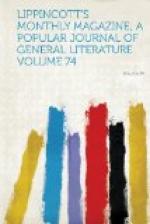stones (a back-breaking operation, apparently, in
the attitude of laundresses bent over an eternal washboard),
are all highly entertaining. In the store-rooms
we see the handsome sheets of morocco, including the
kangaroo skins from Australia, perforated here and
there with the hunter’s shot, and distinguishable
by the enormous flap which has, in the creature’s
life, encased the tail. Among them all the little
orphaned kid skins, clothed in mourning colors and
so soft and small, look very innocent and interesting.
The distinguishing claim of Wilmington is that of
having been the pioneer to introduce machinery into
this as into other kinds of business. Several
kinds of labor-saving apparatus are explained to us,
and the foresight in building the apartments so that
the skins travel from stage to stage with the least
possible lifting is pointed out. These economies
are said to be unmatched in the world. In this
manufacture the relations of employers with employed,
and amongst each other, would appear to be particularly
happy. The morocco-makers of Wilmington seem to
believe that worth makes the man, that readiness to
do a favor to fellow-manufacturers is what shows the
true “grain,” and that “the rest
is naught but leather and prunello.” In
dealing with their men, Messrs. Pusey, Scott & Co.
have kept up the best relations, and have solved the
difficult, the crucial problem in these latitudes,
of inducing whites and negroes to labor side by side
at the same task in harmony. We believe that
this one fact alone, if we were able to develop it
eloquently, would be found to stamp the character of
the principals with the best traits of benevolence,
tact and sense. Mr. Warner, our guide through
the premises, concludes the exhibition by showing
us a curious set of great books in the counting house,
where the foreman of each department records his answer
daily to a list of printed questions, stating his
figures, his ideas, reports, suggestions and complaints.
This diurnal inquisition, which morally gives ventilation
to the whole establishment, and relieves difficulties
at their start, seems to be another indication of an
enviable relationship, keeping up an excellent, old-fashioned
sympathy between employers and operatives.
From morocco-dressing to carriages, which are curtained
and cushioned with morocco, is not a difficult step.
La Bruyere, who wrote a whole book without making
any transitions, would have passed without effort
from the establishment of Pusey, Scott & Co. to the
coach-factory of McLear & Kendall. It should
be premised that coach-building is another of the
very special successes of Wilmington. She produced
last year an amount, in cash value, of carriages greater
than her iron ships, greater than her cotton fabrics,
being one million four hundred thousand dollars.
The engraving shows the outside magnitude of McLear
& Kendall’s factory, the largest in the city,
but cannot show the curious effect of the great show-room,




